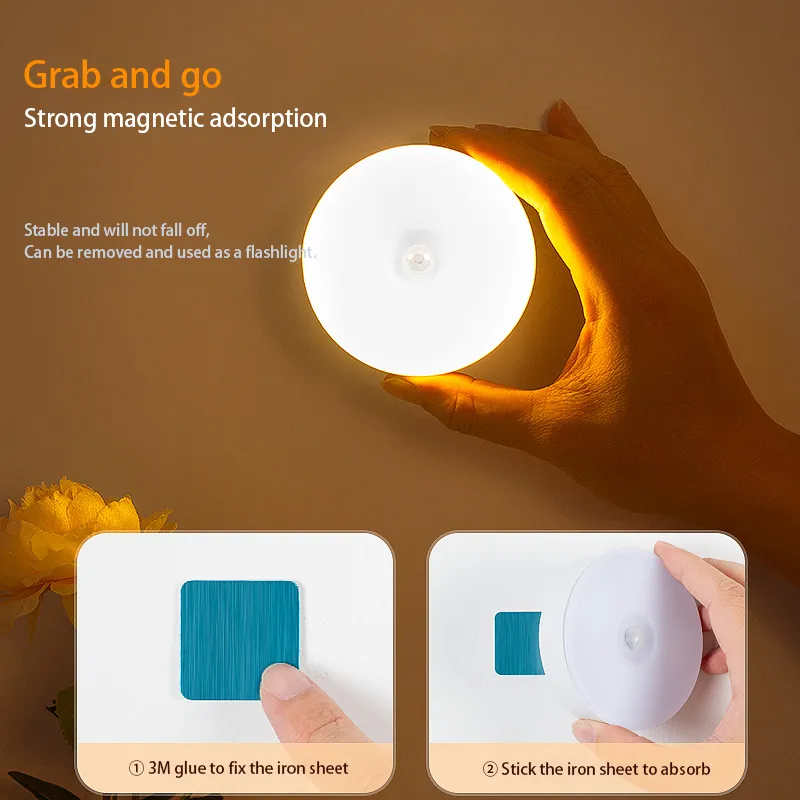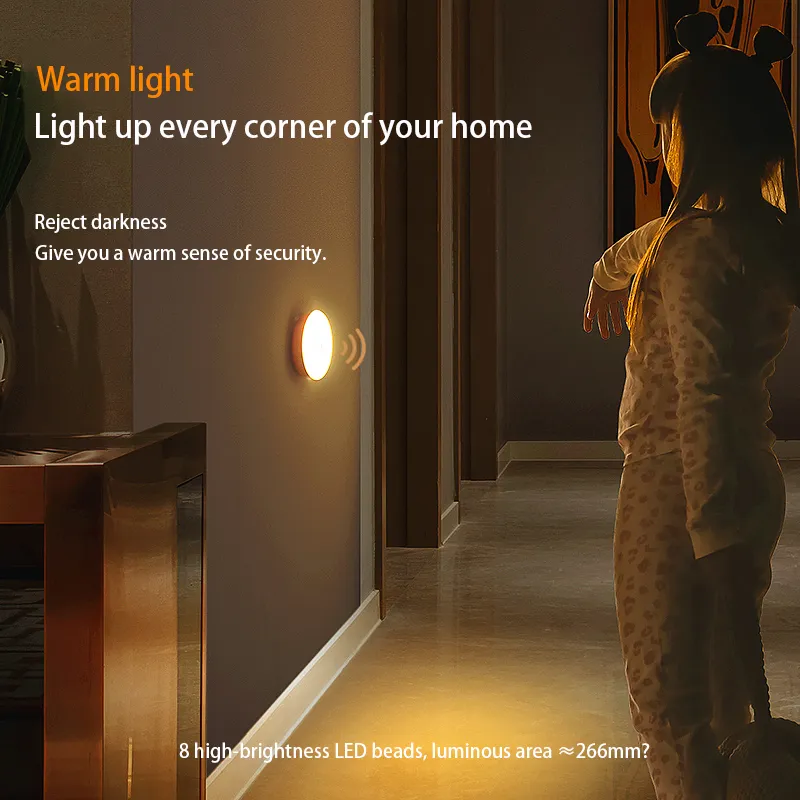Does the led sensor night light generate heat?
The led sensor night light uses sensing technology to automatically light up in the dark, providing users with convenient night lighting. However, many consumers have questions when using these devices: Does the led sensor night light generate heat? How much heat do they generate? Will this heat affect the safety or service life of the product?
This article will focus on these issues and explore the working principle, heating phenomenon, and related safety and performance issues of the led sensor night light.

What is the led sensor night light?
The led sensor night light is a small lamp that combines LED lighting technology and sensor technology. Unlike traditional night lights, the led sensor night light has a built-in light sensor or infrared sensor, which enables it to automatically turn on or off when the ambient light is dim or a person passes by. Through sensing technology, this lamp avoids the trouble of manually operating the switch, and is especially suitable for use in bedrooms, corridors, bathrooms and other places. The led sensor night light is usually low in brightness and is designed to provide soft, comfortable light to avoid overly glaring light sources that affect nighttime rest.
As a light source, LED lamps have gradually replaced traditional incandescent lamps and fluorescent lamps due to their advantages of energy saving, long life and environmental protection, and have become the lighting choice for many families. The LED sensor night light has moderate brightness and convenient functions, making it one of the essential products in the home lighting system.

How does the LED sensor night light work?
The LED sensor night light usually includes the following key components:
LED light source
The LED light source is its main lighting part. LED lamps use light-emitting diode technology. Compared with traditional incandescent or fluorescent lamps, LED lamps have higher light efficiency and lower energy consumption.
Sensor
The LED sensor night light is equipped with various types of sensors. The most common ones are light sensors and infrared sensors. Light sensors can sense changes in ambient light. When the ambient light is dark, the lamp will automatically light up. Infrared sensors can sense the presence of human bodies. When a human body passes by, the lamp will automatically light up.
Control circuit
The function of the control circuit is to connect the sensor with the LED light source and control its on and off. After the sensor detects changes in the environment, it sends a signal to the control circuit, which then responds and activates the LED light source.
Battery or power supply
LED sensor night light is generally powered by batteries or power adapter. Many LED night lights are designed as low-power devices to ensure long-term use without frequent battery replacement.

Does LED sensor night light generate heat?
The heating problem of LED sensor night light has always been the focus of consumers, especially whether it will have adverse effects on the use environment or the device itself when it is turned on for a long time. To answer this question, we need to analyze it from multiple aspects:
The heating characteristics of LED lamps
The working principle of LED lamps is different from that of traditional bulbs. Traditional incandescent lamps generate light by heating metal wires during the light-emitting process, and this process is accompanied by a large amount of heat release. LED lamps emit light through the movement of electrons in semiconductor materials, with high energy conversion efficiency and low heat generation. Generally, LED lamps themselves have low heat, which makes LED lamps the preferred choice for many applications.
However, although LED lamps have relatively low heat, they still generate some heat. Especially in higher-power LED lamps, heat accumulation may be more obvious, especially when the design or heat dissipation system of the LED lamp is not optimized. For LED sensor night lights, heat generation is usually negligible due to their low power.
The impact of sensing technology on heat generation
One of the core features of LED sensor night light is that it can automatically sense changes in the surrounding environment and then decide whether to turn it on or off. The sensors of these lamps do not directly affect the heat generation of LED lamps, but rather change the on-off state of LED lamps. Since LED sensor night lights are usually in standby mode and only light up when the ambient light is dim or a moving object passes by, their heat generation is greatly reduced.
Relationship between working time and heat generation
The heat generation of LED lamps is usually related to their working time and power. LED sensor night lights are generally low in power, usually between a few watts and more than ten watts, and such power output does not generate a lot of heat. Even during long-term use, due to the high efficiency of the LED lamp itself, the heat generated is relatively small. Therefore, LED sensor night light will not have a significant impact on the indoor temperature in daily use.
Heat dissipation design and heat generation
Although LED lamps themselves generate less heat, unreasonable heat dissipation design may still lead to heat accumulation. The heat dissipation design of LED lamps usually uses a heat sink or heat sink to enhance heat dissipation and reduce the operating temperature. If the heat dissipation design of the led sensor night light is not adequate, it may cause local overheating, which in turn affects the life and performance of the lamp. To avoid this, consumers should choose products with good brand reputation and reasonable heat dissipation design.

Is the heat generation of the led sensor night light safe?
Although the led sensor night light generates a small amount of heat, its overall heat generation is much lower than that of traditional incandescent or halogen lamps, so it is unlikely to pose a safety hazard to the use environment or users. To ensure safe use, consumers should still pay attention to the following safety points when using the led sensor night light:
Choose products with quality certification
There are some low-quality LED lamps on the market with improper heat dissipation design, which may cause overheating. Therefore, consumers should choose led sensor night lights that have passed quality certification and ensure that they meet relevant safety standards.
Avoid excessive use
Although the heat generation of LED lamps is relatively low, long-term use may still cause the surface temperature of the lamp to rise. Therefore, consumers should avoid turning on the led sensor night light for unnecessary long periods of time, especially when no one is passing by or the ambient light is bright.
Regular cleaning and maintenance
The heat dissipation performance of the led sensor night light will be affected by dust and dirt. Regular cleaning of lamps can ensure the normal operation of the heat dissipation system and prevent heat accumulation. Especially during use, lamps may accumulate dust and affect their heat dissipation efficiency. Therefore, keeping lamps clean is an important measure to ensure their safety.
Huari Lighting Co., Ltd, established in 1996, is a leading manufacturer of high-quality LED lighting solutions in China. With over 92,000 square meters of production space and a capacity to produce over 1 million lighting fixtures each month, we offer a wide range of LED products for diverse applications. Our product lines include LED downlights, ceiling lights, panel lights, track lights, wall lights, and cabinet lights, all designed to meet the needs of international customers. As a trusted supplier and manufacturer, we offer competitive prices and customized solutions to cater to your specific requirements.
